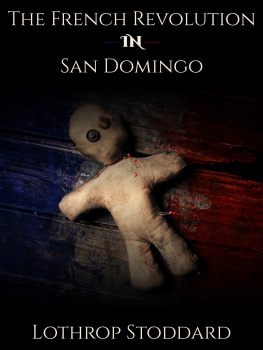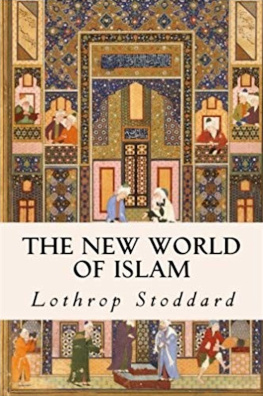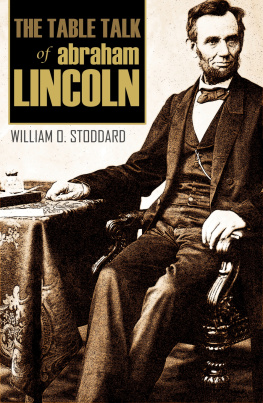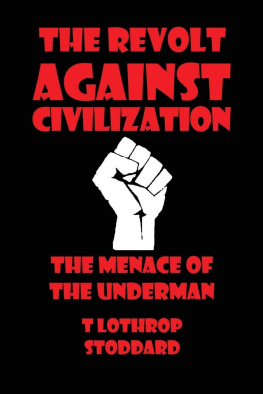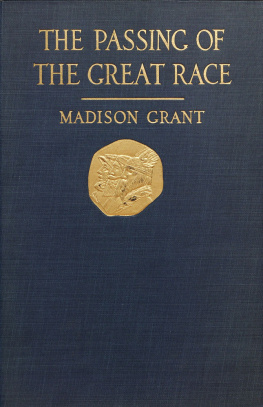THE
RISING TIDE OF COLOR
AGAINST WHITE WORLD-SUPREMACY
BY
LOTHROP STODDARD , A.M., Ph.D. (Harv.)
AUTHOR OF THE STAKES OF THE WAR,
PRESENT-DAY EUROPE: ITS NATIONAL STATES OF MIND,
THE FRENCH REVOLUTION IN SAN DOMINGO, ETC.
WITH AN INTRODUCTION BY
MADISON GRANT
CHAIRMAN NEW YORK ZOOLOGICAL SOCIETY; TRUSTEE AMERICAN
MUSEUM OF NATURAL HISTORY; COUNCILLOR AMERICAN GEOGRAPHICAL SOCIETY;
AUTHOR OF THE PASSING OF THE GREAT RACE
NEW YORK
CHARLES SCRIBNERS SONS
1921
Copyright, 1920, by
CHARLES SCRIBNERS SONS
All rights reserved
Published April, 1920
Reprinted June, July, September, October, 1920;
February, 1921
PREFACE
More than a decade ago I became convinced that the key-note of twentieth-century world-politics would be the relations between the primary races of mankind. Momentous modifications of existing race-relations were evidently impending, and nothing could be more vital to the course of human evolution than the character of these modifications, since upon the quality of human life all else depends.
Accordingly, my attention was thenceforth largely directed to racial matters. In the preface to an historical monograph (The French Revolution in San Domingo) written shortly before the Great War, I stated: The world-wide struggle between the primary races of mankindthe conflict of color, as it has been happily termedbids fair to be the fundamental problem of the twentieth century, and great communities like the United States of America, the South African Confederation, and Australasia regard the color question as perhaps the gravest problem of the future.
Those lines were penned in June, 1914. Before their publication the Great War had burst upon the world. At that time several reviewers commented upon the above dictum and wondered whether, had I written two months later, I should have held a different opinion.
As a matter of fact, I should have expressed myself even more strongly to the same effect. To me the Great War was from the first the White Civil War, which, whatever its outcome, must gravely complicate the course of racial relations.
Before the war I had hoped that the readjustments rendered inevitable by the renascence of the brown and yellow peoples of Asia would be a gradual, and in the main a pacific, process, kept within evolutionary bounds by the white worlds inherent strength and fundamental solidarity. The frightful weakening of the white world during the war, however, opened up revolutionary, even cataclysmic, possibilities.
In saying this I do not refer solely to military perils. The subjugation of white lands by colored armies may, of course, occur, especially if the white world continues to rend itself with internecine wars. However, such colored triumphs of arms are less to be dreaded than more enduring conquests like migrations which would swamp whole populations and turn countries now white into colored mans lands irretrievably lost to the white world. Of course, these ominous possibilities existed even before 1914, but the war has rendered them much more probable.
The most disquieting feature of the present situation, however, is not the war but the peace. The white worlds inability to frame a constructive settlement, the perpetuation of intestine hatreds, and the menace of fresh white civil wars complicated by the spectre of social revolution, evoke the dread thought that the late war may be merely the first stage in a cycle of ruin.
In fact, so absorbed is the white world with its domestic dissensions that it pays scant heed to racial problems whose importance for the future of mankind far transcends the questions which engross its attention to-day.
This relative indifference to the larger racial issues has determined the writing of the present book. So fundamental are these issues that a candid discussion of them would seem to be timely and helpful.
In the following pages I have tried to analyze in their various aspects the present relations between the white and non-white worlds. My task has been greatly aided by the Introduction from the pen of Madison Grant, who has admirably summarized the biological and historical background. A life-long student of biology, Mr. Grant approaches the subject along that line. My own avenue of approach being world-politics, the resulting convergence of different view-points has been a most useful one.
For the stimulating counsel of Mr. Grant in the preparation of this book my thanks are especially due. I desire also to acknowledge my indebtedness for helpful suggestions to Messrs. Alleyne Ireland, Glenn Frank, and other friends.
Lothrop Stoddard.
New York City ,
February 28, 1920.
CONTENTS
| PAGE |
| Introduction by Madison Grant |
| THE RISING TIDE OF COLOR |
| CHAPTER |
| The World of Color |
| Yellow Mans Land |
| Brown Mans Land |
| Black Mans Land |
| Red Mans Land |
| THE EBBING TIDE OF WHITE |
| The White Flood |
| The Beginning of the Ebb |
| The Modern Peloponnesian War |
| The Shattering of White Solidarity |
| THE DELUGE ON THE DIKES |
| The Outer Dikes |
| The Inner Dikes |
| The Crisis of the Ages |
| Index |
MAPS
| PAGE |
| I |
| Distribution of the Primary Races |
| II |
| Categories of White World-Supremacy |
| III |
| Distribution of the White Races |
INTRODUCTION
Mr. Lothrop Stoddards The Rising Tide of Color, following so closely the Great War, may appear to some unduly alarming, while others, as his thread of argument unrolls, may recoil at the logic of his deductions.
In our present era of convulsive changes, a prophet must be bold, indeed, to predict anything more definite than a mere trend in events, but the study of the past is the one safe guide in forecasting the future.
Mr. Stoddard takes up the white mans world and its potential enemies as they are to-day. A consideration of their early relations and of the history of the Nordic race, since its first appearance three or four thousand years ago, tends strongly to sustain and justify his conclusions. For such a consideration we must first turn to the map, or, better, to the globe.
Viewed in the light of geography and zology, Europe west of Russia is but a peninsula of Asia with the southern shores of the Mediterranean Sea included. True Africa, or rather Ethiopia, lies south of the Sahara Desert and has virtually no connection with the North except along the valley of the Nile.
This Eurasiatic continent has been, perhaps, since the origin of life itself, the most active centre of evolution and radiation of the higher forms.
Confining ourselves to the mammalian orders, we find that a majority of them have originated and developed there and have spread thence to the outlying land areas of the globe. All the evidence points to the origin of the Primates in Eurasia and we have every reason to believe that this continent was also the scene of the early evolution of man from his anthropoid ancestors.
The impulse that inaugurated the development of mankind seems to have had its basic cause in the stress of changing climatic conditions in central Asia at the close of the Pliocene, and the human inhabitants of Eurasia have ever since exhibited in a superlative degree the energy developed at that time. This energy, however, has not been equally shared by the various species of man, either extinct or living, and the survivors of the earlier races are, for the most part, to be found on the other continents and islands or in the extreme outlying regions of Eurasia itself.
Next page

